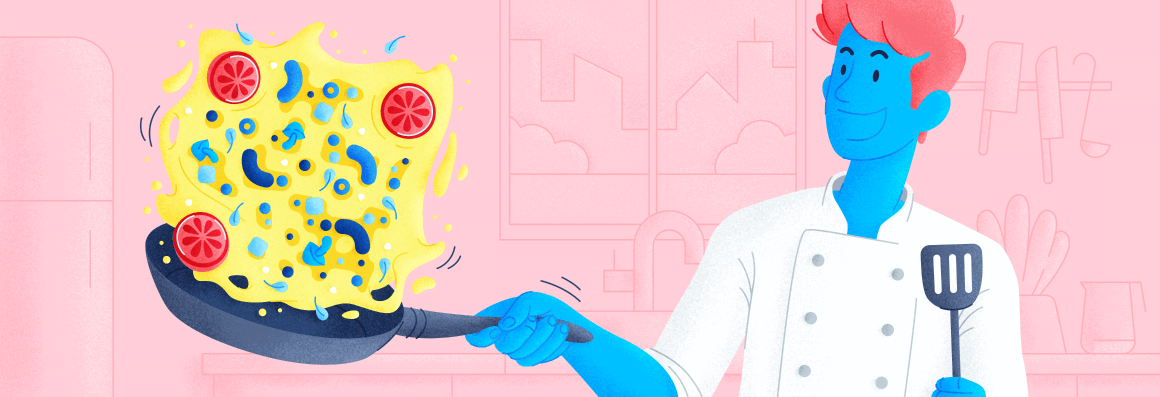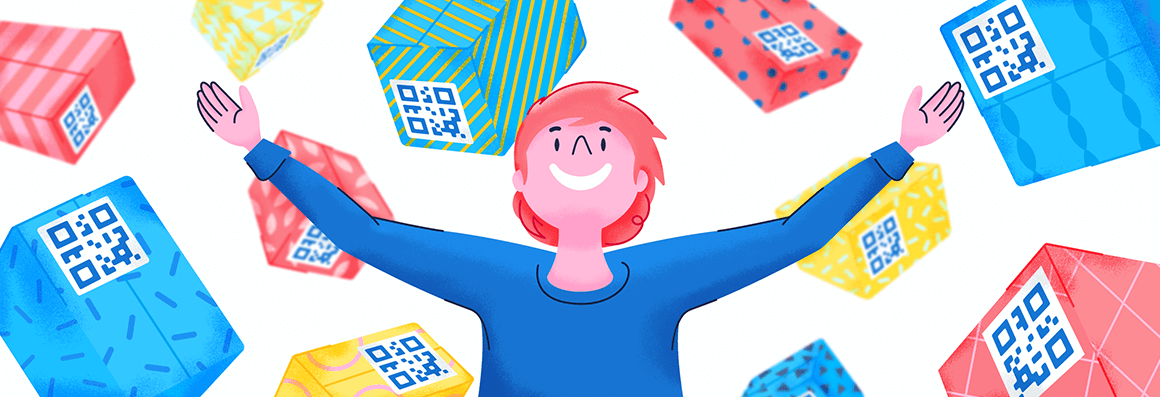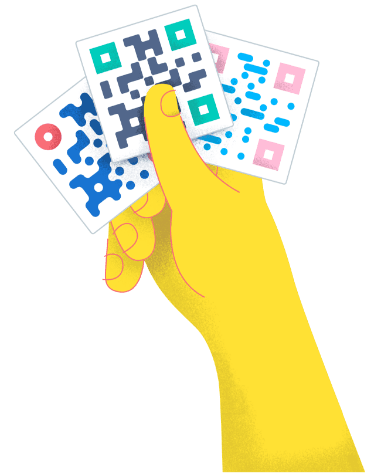- Best Practices ●
- COVID-19 ●
- Industry Trends ●
- Partners ●
- Product ●
How To Upgrade Your Marketing by Using QR Codes for Recipes
These days, the pool of people launching cookbooks isn’t just for chefs; foodies, nutritionists, food bloggers/vloggers, and the like are curating recipes—opening up the possibilities for more to dive into the universe of food content creation. The door is wide open for anyone with an unrelenting passion for food.
But that doesn’t mean that food content creation or starting a food biz is easy—quite the contrary. Developing recipes, launching cookbooks, and attracting visitors to your recipe blog/vlog requires a marketing strategy from the divine—by that, we mean QR Codes.
If you stick around, you’ll discover just how much our QR Code types are the perfect ingredients for your food business. So tag along, food enthusiasts, and follow our recipe!
Benefits of using recipe QR Codes for food marketing
QR Codes offer state-of-the-art marketing assistance for publishing your recipe book and building an online reputation on your recipe blog/vlog or social media channels. Plus, it can be used on virtually any material. Here are some reasons to consider incorporating custom QR Codes into your food marketing strategy:
Offers a more convenient way to share more
Ever read a recipe and wondered how the publisher jumped from one step to another? Or have you ever found some instructions so general that you had to do some guesswork and ended up with something completely different from what you imagined?
If so, you’re not alone. A quick look at the comment sections of many food blogs and vlogs will reveal that people often have questions.
How do you ensure your readers have everything they need to prepare tasty dishes? Simple: QR Codes. They’re a convenient means to share information you can’t fit in typical food blogs or cookbook pages.
With QR Codes, you can provide video content that details each step in your recipes, cooking instructions in other languages to broaden your audience, and interactive content to boost engagement.
Connects your audience to your social media platforms
Let’s say you have online traffic on your website, but no one has taken notice of your mouth-watering food content creation on your social media platforms. What do you do? Make them notice, of course—subtly.
All they need is a gentle nudge in the right direction by placing a Social Media QR Code on your website that directs them to all your social media channels in just one scan. You can also add a QR Code for reviews to direct site visitors to review sites that rate your recipes or culinary skills.
Compatible with digital and print materials
You can infuse QR Codes into a wide array of marketing materials. Their versatility allows you to place them on or in your hardcover recipe cookbook, your web banner on your recipe blog, or on your social media channels—the choice is yours.
Want to broadcast the news about your food content? There’s a whole library of QR Code marketing materials, from using them as QR Code stickers to QR Code signage and plenty more!
Customizable for your brand
You can forget about the word “limitation” when it comes to QR Codes. They’re highly customizable and offer creative liberty, making them the perfect tool for businesses or individuals concerned about maintaining consistent branding.
You have the creative license to add the logo, colors, frame, and style that represents your brand. We’re in the business of making your brand more recognizable and making sure you’re happy with a QR Code design that fits with your brand image.
A borderline perfect call to action
A QR Code call to action is clear and direct. When you see a QR Code ad, it instructs you on what to do next: “Scan me,” “Follow,” and “Like” are some of the CTAs (calls to action) you can use to drive your audience to take action. They’re not only direct but also playful, making them the perfect tool if you want to avoid appearing too salesy.
5 tasty ways to use QR Codes for recipe promotions
QR Codes are versatile tools—you can use them for anything from sharing information with your target audience to enhancing the effectiveness of marketing tools. And the best part? You never have to worry about QR Code sustainability because they’re not only easy to generate but also environmentally friendly, as they eliminate the need for too much paper.
So, how do you use QR Codes for recipe promotions? Read on as we delve into some creative ideas:
1. Integrate QR Codes into the design of your cookbook
Sure, your cookbook may be doing well. But do you know what would make it do even better? QR Codes. They allow you to offer in-depth guidance and connect more with your audience.
Ditch sharing clunky URL addresses in your cookbook and adopt QR Codes for recipes instead. Inside, outside, on top of—wherever there’s a space for a square block, make QR Codes part of the design of your recipe book. Connect the reader from your cookbook to the online world, where you can interact with them in a different format.
Try the Social Media QR Code for all your socials, the Dynamic URL QR Code to link to your recipe website or the video QR Code for video content. You can never go wrong with video QR Codes, as videos humanize brands, increasing their chances of success.
Just look at Jamie Oliver: We don’t only love him for his undeniably incredible recipe books; we love him as a personal brand—his charming personality, his unfaltering passion for food, and his unpretentious guidance for many home cooks. For years, many have connected to his down-to-earth demeanor via video format.
QR Codes may be the answer you’ve been looking for to make a name for yourself in the food space. Using the video QR Code, for example, enables your audience to build a connection with your content beyond the pages. Instead of learning how to cook a spaghetti carbonara through the traditional format, you’re inviting your audience to whip up a meal through video so that they feel as if they’re in the kitchen with you, guiding them step by step.
Now, isn’t that a breath of fresh air? The best part is you still experience the joy of print with a touch of tech—intersecting the best of both worlds simultaneously.
QR Codes for recipes give readers access to Elena Brook’s instructional video in The Foodie Bible. Photo by Rodnae production on Pexels
2. Incorporate web banners onto your recipe website
Let’s be honest—beginners can find competing against established chefs and food enthusiasts challenging. How do you market a new cookbook and improve its chances of selling almost as well as books published by people who’ve been in the industry longer?
It’s simple: by being creative.
If you have a webpage, leverage it by selling your new cookbook to loyal readers first. Use web banners to entice them with special offers exclusive to them, like coupons. If you decide to go with this idea, create a Coupon QR Code that allows site visitors to get immediate offers when purchasing your book. Incorporate the QR Code into your web banner and place it somewhere visible on your website. Also, include a CTA to let readers know what to expect after scanning the code.
Make your cookbook discount visible to your website visitors with QR Code banners.
3. Overdeliver with a free ebook
EBooks are among the most successful lead-generation tools, as they allow you to collect potential customer information, which you can use to market your recipes and cookbooks. Even so, it’s becoming increasingly crucial for businesses to think outside the box, as simply collecting leads isn’t enough—roughly 44% of direct mail isn’t opened.
That’s where our idea comes in. You can increase your chances of converting leads into sales by incorporating QR Codes into your free ebook. Use them to direct readers to other channels that offer value.
For example, you can use Social Media QR Codes to share content about your recipes on social platforms. The more value you offer, the higher the chances your target audience will purchase your cookbooks, recipes, and other products.
Direct your users from your eBook to your social media page with a Social Media QR Code.
4. Create an all-in-one recipe and shopping list
Finding high-quality ingredients is vital, especially for professional chefs or bakers. The wrong ingredients can break a dish and prevent you from achieving the desired tastes. And, with food critics popping up everywhere, these aren’t risks you can take.
So, how do you ensure your team knows where to get the best ingredients and prepare them without having them drag long recipes or bulky cookbooks everywhere? By creating QR Codes that link to detailed shopping lists and recipes.
You can generate a PDF QR Code, URL QR Code, or even an MP3 QR Code if you prefer to give audio instructions. They’ll help your team and audience ensure culinary accuracy throughout every step of the food prep process.
Bilberries’ Hillside Farm’s email newsletter features something new for its subscribers.
5. Start selling food products
Let’s say your business is really taking off, and you’re ready to take it up a notch. Consider developing your own food product and selling it on the market. Selling your food product—whether that’s your unique cookie mix, your grandma’s secret hot sauce, or your dad’s jars of jam—can help you level up in your business.
The advantage of selling your own food product is that you have full creative control over the packaging and marketing of your product. That means you can put whatever you like on your product packaging. And if you’d like to share a recipe you’ve developed and direct consumers to your website, there’s a simple route to do that—implementing a QR Code on packaging.
Using a QR Code recipe on the packaging is also a way to retrieve more online traffic to your website. Try the Dynamic QR Code to link your food blog to your product so you can get your customers to browse your website for food content and other food products.
Betty Bakes’s Chocolate Baking Chips display a QR Code for their recipe suggestions.
Examples of how to use QR Codes for recipes and food marketing
Many chefs, bakers, and professional food marketers have already realized the immense benefits of QR Codes and incorporated them into their marketing strategies. Here are some examples:
Fustini’s library of recipes
Fustini’s is an Italian-inspired brand that sells bottles of olive oil and balsamic vinegar—two essential pantry ingredients. During the heart of the coronavirus pandemic, Fustini’s noticed a trend in utilizing QR Codes, which sparked a revolutionary idea: adding a QR Code to its bottle labels.
Once the concept was born, the brand went full steam ahead and designed a QR Code that directed users from the bottle to a webpage. The webpage is a library of recipes that incorporate Fustini’s olive oil and balsamic vinegar. From scanning to cooking, users can create a feast of meals—all in one place.
Fustini’s products show us that the potential of using packaging to share recipes is possible. They also make for great gift ideas for the food enthusiast who’s always on the hunt to try new recipes. Can you imagine a future where we scan food for recipes? It’s not far out of reach anymore, thanks to QR Code labels.
“Cook This Book” by Molly Baz
A modern cookbook has reached the racks and the hearts of many with the desire to learn culinary skills. Traditional cookbooks only show the instructions in writing, but this cookbook is no ordinary one: it has QR Codes.
Molly Baz is known for her work as a former food editor at Bon Appétit, but among other things, she’s a cook, recipe developer, video host, and foodie at heart. The colorful pages of her new book, Cook This Book, are filled with QR Codes, which contribute to its minimalist aesthetic.
But it’s not only the clever design that makes you want to pick it up and cook up a storm: it’s practical and convenient for novice to intermediate home cooks. It’s for the humble home cook who secretly wants to know how to chop an onion correctly or the aspiring MasterChef who wants to try their whisk at making a kick-ass aioli.
Readers can learn and master all of these more complex culinary techniques through short video tutorials when they scan a QR Code recipe, eliminating the need for lengthy online searches or trial-and-error experiments. A touch of tech in this contemporary cookbook demonstrates how easy it is to innovate the traditional recipe book.
“The Augmented Reality Baking Book” by Jessica Prézeau
This cookbook brings all the spice to the art of cooking. It shows we don’t have to confine information sharing to text by combining traditional recipes with augmented reality (AR) technology and QR Codes. To activate the interactive visuals brought on by AR technology, you only need to scan the QR Codes in the book.
Integrating QR Codes and AR is ingenious, as it increases recipe accessibility. It also enhances engagement and limits the risk of making mistakes at any step in the baking process, as you get detailed visual guidance. Whether you’re a novice or an experienced baker looking for motivation and guidance, rest assured that this game-changing book will reignite your passion for baking.
Make food marketing a whole lot tastier with QR Codes
Relying solely on printed material in the modern tech-based world may keep you from elevating your brand. Integrate QR Codes into your food marketing strategy to make it easier for people to access culinary tips and recipes, and watch as your popularity and engagement rates soar.
With QR Code Generator PRO, there are no limits on how you can use QR Codes for food marketing. Whether you need a video QR Code to direct food enthusiasts to detailed video content, a PDF QR Code listing all your ingredients, or a Coupon QR Code to offer exclusive deals, rest assured you have the right tool.
Sign up for QR Code Generator PRO today to elevate your recipes, streamline food preparation, ensure culinary accuracy, and boost your cookbook sales!





